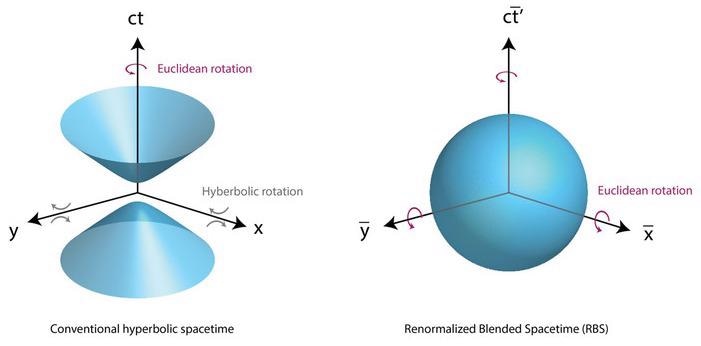May 28 2021
Focused on crystal structures, a researcher from the Pennsylvania State University (Penn State) has designed a novel mathematical formula that might solve an ancient issue in interpreting spacetime—the foundation of the universe suggested in Albert Einstein’s theories of relativity.
 A diagram showing the process of creating “renormalized blended spacetime.” Penn State scientist Venkatraman Gopalan is studying crystal structures and has developed a new mathematical formula that may solve a decades-old problem in understanding spacetime, the fabric of the universe proposed in Einstein’s theories of relativity. Image Credit: Hari Padmanabhan, Penn State.
A diagram showing the process of creating “renormalized blended spacetime.” Penn State scientist Venkatraman Gopalan is studying crystal structures and has developed a new mathematical formula that may solve a decades-old problem in understanding spacetime, the fabric of the universe proposed in Einstein’s theories of relativity. Image Credit: Hari Padmanabhan, Penn State.
Relativity tells us space and time can mix to form a single entity called spacetime, which is four-dimensional: three space-axes and one time-axis. However, something about the time-axis sticks out like sore thumb.
Venkatraman Gopalan, Professor of Materials Science and Engineering and Physics, Pennsylvania State University
To make sure that calculations work within relativity, researchers would first need to introduce a negative sign on time values, which does not have to be placed on space values. While physicists have understood the concept to work with the negative values, it also implies that spacetime cannot be tackled with conventional Euclidean geometry but instead should be visualized using the more intricate hyperbolic geometry.
Gopalan has devised a two-step mathematical strategy that helps blur the variations between time and space, thus eliminating the problem of the negative sign and acting as a bridge between both geometries.
For more than 100 years, there has been an effort to put space and time on the same footing. But that has really not happened because of this minus sign. This research removes that problem at least in special relativity. Space and time are truly on the same footing in this work.
Venkatraman Gopalan, Professor of Materials Science and Engineering and Physics, Pennsylvania State University
Recently published in the Acta Crystallographica A journal on May 27th, 2021, the article is accompanied by a commentary where a couple of physicists have cited that Gopalan’s mathematical approach may provide the solution to combine gravity and quantum mechanics—two fundamental areas of physics that have not been completely unified yet.
“Gopalan’s idea of general relativistic spacetime crystals and how to obtain them is both powerful and broad. This research, in part, presents a new approach to a problem in physics that has remained unresolved for decades,” stated Martin Bojowald, Professor of Physics from Penn State.
Apart from offering a whole new method to relate spacetime to conventional geometry, the new study holds implications for designing novel structures with unusual properties, called spacetime crystals.
In crystals, atoms are arranged in a repeated pattern, and in the recent past, scientists have investigated the theory of time crystals, where the state of a material alters and also repeats in time, similar to a dance.
But time is delinked from space in such formulations. Gopalan’s approach would help explore a new set of spacetime crystals in which time and space can combine together.
These possibilities could usher in an entirely new class of metamaterials with exotic properties otherwise not available in nature, besides understanding the fundamental attributes of a number of dynamical systems.
Avadh Saxena, Physicist, Los Alamos National Laboratory
The technique devised by Gopalan involves combining a couple of individual observations of the same event. Blending takes place when a couple of observers exchange time coordinates but still maintain their own space coordinates. With renormalization—an extra mathematical step—this results in “renormalized blended spacetime.”
“Let’s say I am on the ground and you are flying on the space station, and we both observe an event like a comet fly by. You make your measurement of when and where you saw it, and I make mine of the same event, and then we compare notes. I then adopt your time measurement as my own, but I retain my original space measurement of the comet,” added Gopalan.
“You in turn adopt my time measurement as your own, but retain your own space measurement of the comet. From a mathematical point of view, if we do this blending of our measurements, the annoying minus sign goes away,” concluded Gopalan.
The study was funded by the National Science Foundation.
Journal Reference:
Gopalan, V (2021) Relativistic spacetime crystals. Acta Crystallographica A. doi.org/10.1107/S2053273321003259.